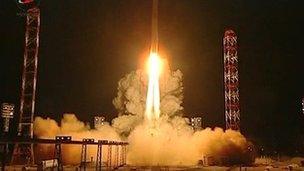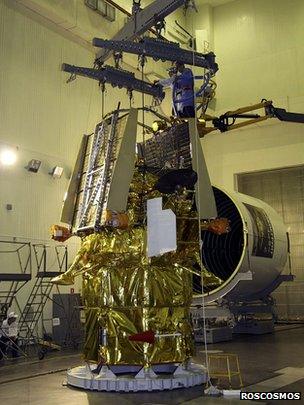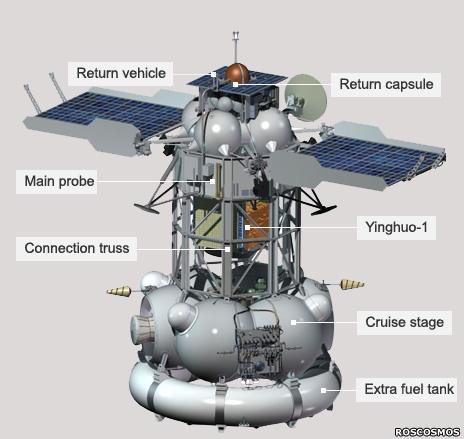Phobos-Grunt Mars probe loses its way just after launch
- Published

The Phobos-Grunt spacecraft, if salvaged, would reach Mars in late 2012
Russian engineers are fighting to save the country's latest mission to Mars.
The Phobos-Grunt probe launched successfully but then failed to fire the engine to put it on the correct path to the Red Planet.
Russian space agency officials say the craft is currently stuck in an Earth orbit and that engineers have two weeks to correct the fault before the probe's batteries run out.
The project is Russia's most ambitious space venture in recent years.
It has been designed to collect rock and dust samples from Mars' moon Phobos and bring them back for study in labs on Earth.
Scientists hope the dusty debris would provide fresh insights into the origin of the 27km-wide moon, which many scientists suspect may actually be a captured asteroid.
The venture is also significant because it is carrying China's first Mars satellite. Yinghuo-1 is riding piggyback on Phobos-Grunt.
The two craft lifted off from the Baikonur cosmodrome in Kazakhstan on a Zenit rocket at 00:16 local time on Wednesday (20:16 GMT Tuesday) and were dropped off in an elliptical orbit around the Earth 11 minutes later.
Almost two and a half hours into the mission, the huge cruise stage attached to Phobos-Grunt should then have made the first of two firings, to raise the orbit and to send the mission on to Mars. Russian officials say neither of those planned engine burns occurred.
Reports suggest the spacecraft attempted to orientate itself in space using the stars, failed to pick them up and therefore did not execute the firings as planned.
"It looks like the engine system has not worked," Vladimir Popovkin, the head of the Russian space agency (Roscosmos), explained.
"It seems it couldn't reorient itself away from the Sun towards the stars so the sidewall closed. It was foreseen by the flight program. Now, we have found its location, and we have to unpack the sidewall, to check the telemetry and after that we will restart the spacecraft control program to reboot the mission."
And he added: "I would not say it's a failure; it's a non-standard situation, but it is a working situation."
If the problem is simply a software issue and engineers can upload new commands, they have a chance of rescuing the mission. If the fault lies in a hardware malfunction, Phobos-Grunt may well be doomed.

Russian scientists were hoping Phobos-Grunt would end a dreadful run of failure for Russia at Mars
Onboard battery power provides just a short window in which to make any corrections. At first, Roscosmos thought this time opportunity might last only days; it now says, "the orbit parameters and fuel supplies on board showed that such commands must be given in the course of two weeks".
"It sounds like the spacecraft has gone into a safe mode," commented British propulsion expert Alan Lawrie from Astrium UK.
"These spacecraft do that if they hit these types of problems. It's a mode whereby the spacecraft knows it cannot do itself any harm, and that gives controllers on the ground the time to get the spacecraft back into the right configuration and to do the correct manoeuvres."
Torrid history
Russia had been hoping that Phobos-Grunt would finally bury its Martian curse.
Moscow has despatched a total of 16 missions to the Red Planet since the 1960s. None has successfully completed its goals, with the most recent endeavour - the sophisticated Mars-96 spacecraft - being destroyed in a failed launch.
Provided engineers can correct the current problem, Phobos-Grunt should reach Mars late next year.
After dumping the cruise stage and releasing Yinghuo-1, the main spacecraft would then manoeuvre itself into position to land on Phobos.
Phobos-Grunt is a hefty spacecraft, requiring several elements to complete the tasks of travelling out to Mars, landing on Phobos, picking up its samples and then despatching them home.
The total mass for the mission with all its fuel is more than 13 tonnes. That makes it a bigger venture even than the six-tonne Cassini-Huygens craft, launched to Saturn in 1997 and the heaviest space mission of recent times.
Detailed mapping of the moon has been conducted by the European Space Agency's Mars Express (MEx) satellite, and this information is being used to identify a suitable location to land in February 2013.
Once on the surface, a robotic arm will pick up samples of the regolith ("soil"). Some of this material will be analysed there and then, but a portion of it - about 200g - will be transferred to a canister for return to Earth.
This canister and its departure stage should be sent home within a few days of Phobos-Grunt's arrival on the moon. If all goes well, the canister should fall to Earth in the Kazakh desert in August 2014.

Potato-shaped Phobos is a fascinating target. Although it has been studied extensively by passing satellites, it still holds many secrets - not just about itself, but also the planet below.
It is one of two moons at Mars (the other being Deimos). It has an extremely low density, indicating it probably has many interior voids.
Some scientists think it may be a collection of rocky rubble that coalesced around the Red Planet soon after its formation. Another explanation is that it is an asteroid that came close to Mars and got caught in its gravity.

Tardigrades - or "water bears" - are among the species taking a ride on Phobos-Grunt
The French (Cnes) and German (DLR) space agencies have provided instrumentation for Phobos-Grunt. The European Space Agency, in addition to its survey information from MEx, will be providing ground support.
US participation comes in the form of the space advocacy group, The Planetary Society, which is sending its Living Interplanetary Flight Experiment (LIFE) on Phobos-Grunt.
This package of hardy micro-organisms will make the journeys out and back inside a separate compartment in the return capsule.
It will test theories on how living organisms could spread through the Solar System by simulating aspects of the long-duration voyage that microbes could make in a meteoroid that has been blasted off one planetary body and landed on another.
The microscopic participants in LIFE include the bacterium Deinococcus radiodurans, known for its ability to withstand high doses of radiation, and the eight-legged tardigrade (or "water bear"), a microscopic invertebrate that has already demonstrated its ability to survive short exposure to the space environment.
- Published4 November 2011
- Published19 July 2011
- Published21 September 2010